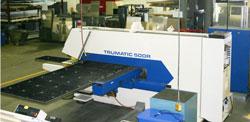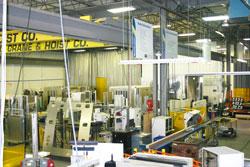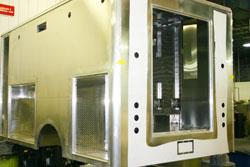Senior Editor
- FMA
- The Fabricator
- FABTECH
- Canadian Metalworking
Categories
- Additive Manufacturing
- Aluminum Welding
- Arc Welding
- Assembly and Joining
- Automation and Robotics
- Bending and Forming
- Consumables
- Cutting and Weld Prep
- Electric Vehicles
- En Español
- Finishing
- Hydroforming
- Laser Cutting
- Laser Welding
- Machining
- Manufacturing Software
- Materials Handling
- Metals/Materials
- Oxyfuel Cutting
- Plasma Cutting
- Power Tools
- Punching and Other Holemaking
- Roll Forming
- Safety
- Sawing
- Shearing
- Shop Management
- Testing and Measuring
- Tube and Pipe Fabrication
- Tube and Pipe Production
- Waterjet Cutting
Industry Directory
Webcasts
Podcasts
FAB 40
Advertise
Subscribe
Account Login
Search
Made to order, for emergency
Ambulance-maker adapts lean principles to custom manufacturing
- By Tim Heston
- May 1, 2012
- Article
- Shop Management

Figure 1: Several years ago Horton Emergency Vehicles manufactured its made-to-order ambulances from the ground up in 16 bays. Final assembly took between five and 16 days, depending on the model. Today two vehicles roll off the line every day.
Horton Emergency Vehicles is the Cadillac of the ambulance market. Customers can customize orders to the nth degree: an aluminum cabinet here, an exterior light there. Several years ago a vehicle could be made in 57 days. Now technicians fabricate and assemble an ambulance, from start to finish, in 37 days. The company essentially reduced its order-to-cash cycle by 20 days. Obviously, something changed for the better.
Horton’s manufacturing floor in Grove City, Ohio, looks nothing like it did several years ago, when workers built ambulances from the ground up in one of 16 assembly bays. Once a job arrived, workers ordered certain components from internal manufacturing departments; receiving those components could take a week or even longer.
Technicians were like painters with a blank canvas. They started with very basic fabricated components; for example, a panel may have been sheared and bent, but it wouldn’t have holes or other prefabricated features. Assemblers looked at the customer’s spec sheet and then cut and joined components per the order. Because Horton was a custom manufacturer, the process, however inefficient, just seemed logical.
“There was no standardization,” said Ricky Loar, operations excellence manager. “In each one of our 16 bays, everybody would have a different way. There was no sense of urgency. We had done it that way for years, and it was just an acceptable way of doing things.”
There was good reason for this. For decades the operation had churned out quality product after quality product. The approach seemed to make sense for such a high-end niche. Customers who wanted highly customized ambulances came to Horton because the company could deliver that kind of product; they just had to wait for it.
“Throughout our history, we’ve always been the top-of-the-line ambulance manufacturer,” Loar said. “We have a dozen different versions of ambulances with different chassis and box styles. Every truck we build is different. In fact, we rarely if ever build the same truck.”
In April 2010 the private equity group American Industrial Partners (AIP) purchased Horton’s parent company, Halcore Group. Now Horton is a member of AIP’s Allied Specialty Vehicles group of companies. Under a new corporate umbrella, Horton managers learned of continuous improvement successes at other AIP companies. It wasn’t long before the new owners gave Horton’s leaders the financial backing for training in lean manufacturing and Six Sigma.
Still, trepidation remained. How could such techniques be adapted to a make-to-order environment? Would lean practices force Horton to provide fewer options for its products? Would Horton still be … Horton?
High-mix Lean Manufacturing
Conventional wisdom says that Toyota-style lean manufacturing fits high-volume, low-mix production. No one would argue that at least some elements of lean manufacturing apply to most operations, but certainly, Horton’s highly custom approach didn’t fit an assembly-line model—right?
Or would it? As Loar recalled, the team started the transformation with few preconceptions. “Initially we created a value stream map of the process, looked at everything from start to finish, and asked, ‘How can we make this better?’”

Figure 2: The fabrication area has a guillotine shear, punch presses, and a 50-ton press brake. These machines produce components that feed into subassembly cells.
Horton’s previous modus operandi had a host of timing problems buried in the lengthy production schedule. Managers could have pointed fingers at plenty of departments, all of which seemed to take too long to deliver parts. But Horton’s leaders soon realized that the root of the problem didn’t lie with any one person or department. It was the entire operation. Departments were set up as if they were external job shops feeding one internal customer: the assembly bays. In other words, the operation wasn’t a coordinated whole.
To that end, Horton’s new assembly line was designed to coordinate the whole (see Figure 1). The line bisects the manufacturing facility; surrounding fabrication, welding, body subassembly, painting, upholstery, and electrical subassembly areas feed components to the main line.
The transformation hinged on perfecting the timing of order releases so that all components would reach assembly at the right moment. It also hinged on changing the kinds of components that technicians assembled. Under the old way, assemblers received components closer to their raw form—sheets cut and bent, but perhaps not with punched holes and certainly not joined with adjacent components. Now workers assembling the vehicle body receive larger subassemblies, each with prefabricated holes and other elements. Every vehicle still is different, but assembly now involves fewer steps because technicians work with fewer building blocks—that is, those large subassemblies.
A New Way to Build an Ambulance
To start, orders are released to the fabrication area, which has a new TRUMPF punch press and laser cutting machine, a 50-ton press brake, two new band saws, and other equipment. This area produces the aluminum components that make up the lion’s share of the vehicle body and internal components, including tubing, panels, and cabinets.
All are put together into large subassemblies that arrive as needed for body assembly.
After body assembly, the vehicle undergoes priming, sanding, and acid etch. The body then meets up with its chassis, be it from International, Kenworth, Freightliner, Ford, or another customer-specified brand. From here, the whole truck rolls into the final assembly line, which has eight stations operating under a 277-minute takt time. Every 277 minutes, a vehicle rolls forward to the next station. It takes four 10-hour shifts for a vehicle to make it through all eight stations.
As Loar explained, “Everything is prestaged and released so that all components meet up exactly at the right time.”
Being a custom manufacturing environment, Horton has altered the lean concepts in the original Toyota approach. For instance, the company does share resources for metal fabrication (see Figures 2-4). Parts from the fabrication and welding areas are fed to subassembly areas as well as certain stations of the main assembly line.
The manufacturer also adapts its approach to takt time, the drumbeat of lean manufacturing. In the production plan, vehicles on the final assembly line move forward one station every 277 minutes—again, that’s two during every 10-hour shift. But it’s impossible to balance a make-to-order manufacturing line perfectly. For this reason, the company cushions the takt time to account for variability in production times. Certain products at specific stations take longer than others; that’s just the nature of any high-product-mix operation. Still, no matter what kind of ambulance is on the line, each step should take no longer than 277 minutes.
Streamlining the Front End
Several years ago, when customers placed an order they got their emergency vehicle within 180 days. Now the order-to-cash cycle takes about 80 days. Still, once an order releases to manufacturing, it takes only 37 days to make an entire vehicle. The remaining 43-plus days are consumed mainly by front-end tasks like sales, order entry, engineering, and purchasing.

Figure 3: A cutoff saw cuts structural tube to length. The cut tube then is sent to the fabrication and subassembly cells behind it, where workers assemble the floor, side walls, and roof of the emergency vehicle body.
That’s why in recent months Loar has spent a lot of time on the road, meeting with dealers. Horton wants to streamline those front-end processes so it takes less time for an initial quote to turn into a released order on the manufacturing floor.
“Salespeople carry proposal drawings for whatever model or chassis,” he said. “The salesperson shows customers that standard drawing and then asks what they’d like to change, and writes those changes on the drawing. They then send that into Horton, and we make a proposal drawing off of that.”
To improve this process, the company has developed a check sheet that salespeople can use to gather information more effectively. As several of the kaizen events have already shown, getting all the information upfront—including vehicle size, chassis requirements, and customer-supplied parts—really matters.
Making the front-end process efficient will take more than a check sheet, though. At this writing, when salespeople submit a request for quote, Horton may take several days to produce a proposal drawing. That, Loar said, will change. The inefficiency occurs because of the way some functions are compartmentalized at Horton. When departments are working together, they can work faster.
For instance, historically the company has separated engineering and spec-writing into two departments. But during drawing development, the spec-writing side hasn’t always communicated with the engineering department, and vice versa. That has opened the door for errors. “So we’re tearing down the wall, literally, between those two departments,” Loar said. “We’re combining those two departments into one.” This will allow for better communication between the two areas.
The purchasing department is undergoing similar changes. In the past the spec-writing department may have overlooked outsourced items that required long lead-times. During several recent kaizen events, managers uncovered ways to streamline communication and make the entire process simpler.
Horton’s goal now is to return a proposal drawing to the dealer or customer within four hours of the initial request. This would allow the prospect to look at that proposal the same day and get all their questions answered from the start. This in turn will make every step that comes after—including order processing and manufacturing—much smoother and more predictable.
Customizing Continuous Improvement
For years Horton’s network of salespeople touted their ability to customize vehicles. In customers’ eyes, this has defined Horton Emergency Vehicles. If people need an emergency vehicle made just so, they call Horton. Although implementing lean manufacturing has standardized work processes, Loar said Horton’s customization ability hasn’t changed. “If we get the right information, we’ll build to suit.”
The improvement initiatives seem to be paying off. Horton’s customers operate in health care and municipal government, arenas facing serious uncertainty. Relative to other manufacturing sectors, the emergency vehicle market is struggling. But you wouldn’t know it at Horton. Business is brisk. “And we attribute it all,” Loar said, “to continuous improvement.”
Efficient Fabrication Part Flow
Alwyn Aliwarga grew up with manufacturing; his father owns an Indonesian textile factory. But when it comes to industrial engineering, he never forgets a certain car wash in 2006. It was just a fundraiser, but Aliwarga looked at the whole operation from an efficiency perspective: soap should go here, brushes here, towels here, wax there.

Figure 4: This fully assembled shell is ready for painting, after which it will meet up with the vehicle chassis and other components in the final assembly stations.
Although he had yet to learn the basics of lean manufacturing, Six Sigma, and other improvement methods, something in his brain clicked. He saw elegance in finding the most efficient path between here and there, be it between a tool and a workpiece on an assembly line, or between a bucket of soap and a dirty car.
This quest for efficient movement led him to the Integrated Systems Engineering department at The Ohio State University (www.ise.osu.edu), and it continues to drive him as an intern at Horton Emergency Vehicles. Several years ago Horton representatives presented at OSU’s Job Shop Lean conference, organized by Professor Shahrukh Irani. Soon after the company hired its first industrial engineering interns from OSU.
Horton currently employs one other intern and Aliwarga, who has been tasked with making the company’s fabrication department more efficient. “The part flow gets a bit complicated,” he said. “Most parts start at the shear and then go to the punch press and press brake, but not all parts flow in the same direction. Some parts may flow to the punch, while others may go from the shear directly to the brake. Then some go from the shear directly to assembly.”
Aliwarga mapped Horton’s fabrication part flow and revealed various opportunities for greater efficiency. As just one example, he proposed moving one welding cell dedicated to joining components for specific subassemblies. The welding cell was in the welding department, not near the subassembly cell it fed parts to. After moving that welding operation near the subassembly cell, parts flowed efficiently.
“There’s also a line-of-sight efficiency,” he added. Welders can see what subassembly technicians are working on, and vice versa. “Communication became easier, because they’re now side by side.”
Such insight requires part-based, not technology-based, thinking. It’s not about making welding, punching, or bending more efficient; it’s about making parts flow more efficiently. Or, as Aliwarga would think, it’s not about the features of this brush or that soap bucket; it’s about efficiently cleaning a dirty car.
About the Author

Tim Heston
2135 Point Blvd
Elgin, IL 60123
815-381-1314
Tim Heston, The Fabricator's senior editor, has covered the metal fabrication industry since 1998, starting his career at the American Welding Society's Welding Journal. Since then he has covered the full range of metal fabrication processes, from stamping, bending, and cutting to grinding and polishing. He joined The Fabricator's staff in October 2007.
subscribe now

The Fabricator is North America's leading magazine for the metal forming and fabricating industry. The magazine delivers the news, technical articles, and case histories that enable fabricators to do their jobs more efficiently. The Fabricator has served the industry since 1970.
start your free subscription- Stay connected from anywhere

Easily access valuable industry resources now with full access to the digital edition of The Fabricator.

Easily access valuable industry resources now with full access to the digital edition of The Welder.

Easily access valuable industry resources now with full access to the digital edition of The Tube and Pipe Journal.
- Podcasting
- Podcast:
- The Fabricator Podcast
- Published:
- 04/16/2024
- Running Time:
- 63:29
In this episode of The Fabricator Podcast, Caleb Chamberlain, co-founder and CEO of OSH Cut, discusses his company’s...
- Trending Articles
How to set a press brake backgauge manually

Capturing, recording equipment inspection data for FMEA

Tips for creating sheet metal tubes with perforations

Are two heads better than one in fiber laser cutting?

Hypertherm Associates implements Rapyuta Robotics AMRs in warehouse

- Industry Events
16th Annual Safety Conference
- April 30 - May 1, 2024
- Elgin,
Pipe and Tube Conference
- May 21 - 22, 2024
- Omaha, NE
World-Class Roll Forming Workshop
- June 5 - 6, 2024
- Louisville, KY
Advanced Laser Application Workshop
- June 25 - 27, 2024
- Novi, MI


























